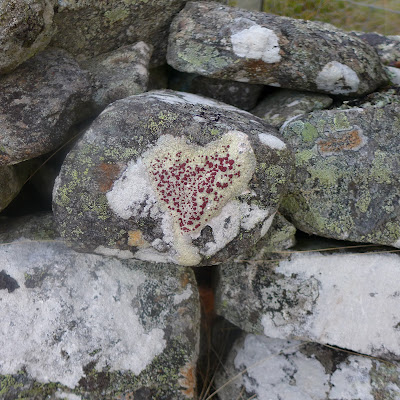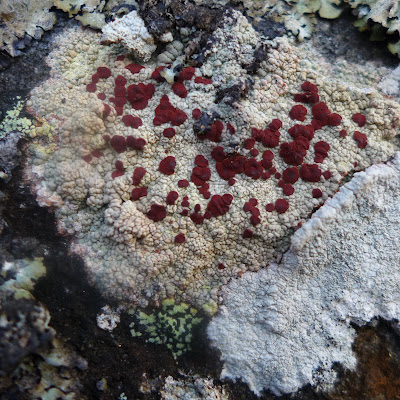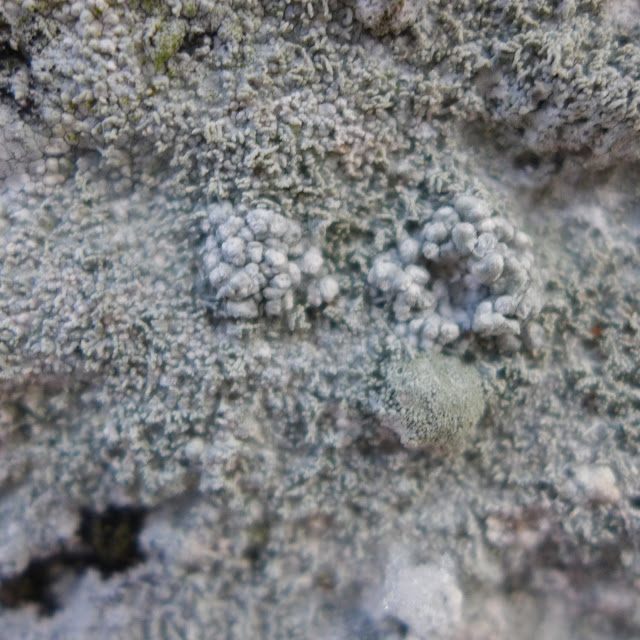I ventured further afield this week, outside the usual 5 mile advice, as my husband had to go to the dentist in Aviemore, which gave me an opportunity to go for a walk and lichen hunt. It was a lovely sunny day, though icy underfoot, and while walking by Milton Burn the sun shone through these strange translucent jellies on a dead sycamore.
Sunday, January 17, 2021
Anyone for jelly?
Thursday, January 14, 2021
An exciting find
I will tell you a tale of why it is so rewarding to record wildflowers and how it can give a lot of pleasure and satisfaction. (I will save the story of how I got around to recording for another post...)
In 2017, I had started looking closely at plants in Newtonmore and trying to identify them. One day I found a plant I had never seen before, flowering in a drainage ditch in a field near Newtonmore Golf Course. It had small white flowers which looked a bit like an umbellifer (the Cow Parsley family). However, instead of having the flowers at the end of the stem, they stuck out at the side. Rather odd.
 |
| Distribution of Apium Nodiflorum records |
 |
| This is what the leaves look like close-up |
 |
| Fool's-water-cress in the stream - it grows in a tangled mess. |
Thursday, December 31, 2020
Dog bones?
In my (limited) experience, most lichen identification depends a lot on matching named photographs to what you have found. This is how I started off identifying wildflowers, flicking through the book to find a picture that looked similar to what I was looking at. Once I started to record what flowers I had found, it became important to make an accurate ID and I moved on to using keys, beginning with a really useful book called "The Wild Flower Key" by Francis Rose.
With flowers, the keys concentrate on what you can see with the naked eye, or sometimes a lens to see small details such as hairs.
However, although there are keys in my lichen book, they quite often use details which amateur observers might not have access to, such as what the spores look like under a microscope, or chemical tests. Also the lichens tend to have just scientific names rather than common ones that are easy to remember, so I have been giving some lichens my own names to try and remember them. When I spot a new lichen, my usual method is to take lots of photos to look at when I get home and compare with photos on the internet.
I found this bright orange lichen on a wall on Newtonmore Main Street, along with some grey lichens and mosses.
I thought an orange one might be easy to identify as there are not that many orange or yellow lichens and most of them have names that begin with Xanthoria.
 |
| Xanthoria parietina on an aspen tree |
 |
| Xanthoria parietina on the left; the new lichen on the right |
I can see that they are different - instead of leafy lobes, the new lichen has smaller lobes that look a bit like dog bones - or when looked at more closely - it looks like battered tempura! So tempura lichen became my name for it...
 |
| (the lines are 1mm apart) |
With some help from the Scottish Lichens Facebook group, it got its real name, Xanthoria elegans, and it also has another name - the Elegant Sunburst lichen.
(Update - after showing some of the photos to another lichen group, they did not think it was Xanthoria elegans - but not enough info to decide what Xanthoria species it was - so it will have to remain as tempura lichen for the time being!)
There is another lichen that reminds me of dog bones, Hypogymnia tubulosa. So here is a quiz for you - can you spot the dog bone lichen?
Wednesday, December 23, 2020
Star Jelly
When walking the dog on the lower section of Newtonmore Golf Course, I saw a blob of translucent whitish jelly, which looked just like the water holding gel you put in hanging baskets, once it has absorbed water and swelled up. I poked it with my foot and wondered how it got there and walked on. A few days later, I saw a picture of something similar on the internet (here) which called it Star Jelly. So I went back to take a photo, though the size of the clump was now smaller. The toe of my boot gives you some indication of the size.
Theories so far: Hans Sluiman, an algae expert at the Royal Botanic Garden Edinburgh, told Out of Doors listeners he is convinced the gel itself is not a plant or animal.
Dr Andy Taylor studies fungi at the Macaulay Institute in Aberdeen. He says there are fungus filaments in the slime but agrees with Hans that they're growing in the gloop rather than creating it.
DNA tests: Andy's team at the Macaulay Institute ran DNA tests on a sample, but the results were inconclusive - the sample was contaminated.
from https://www.bbc.co.uk/scotland/outdoors/articles/jelly/
I think I tend towards the frog theory but who knows....
Monday, December 14, 2020
Stonewalling
I am still enjoying looking out for lichens and I am
gradually getting more familiar with the names.
I have joined a FaceBook page called Scottish Lichens where people are very
helpful and give advice on identifying lichens from your photos.
There is a dry stone wall just by the first cattle grid at the top of Glen Road. There wasn't much to see when I visited it on this day!
However, when the snow has melted, it is full of interesting patterns formed by lichens. Most of the lichens are the crustose ones – they look as if they are painted on – and are stuck to the surface of the stone. They don’t come off if you rub them.
Here are a few – some with names.
 |
| Rhizocarpon geographicum - Map lichen |
 |
| Ophioparma ventosa - Blood spot lichen |
 |
| The "blood spots" are actually reproductive structures. |
 |
| Pertusaria corallina |
Next time you are out for a walk, take time to look closely at walls and boulders. You may be surprised at what you can find.
Sunday, November 29, 2020
Late bloomers
Even though it is almost December, there are still some plants flowering. Some are annuals such as Groundsel, which are growing and flowering probably from seed produced earlier in the year. Others such as Dandelions and Broom are perennials and the mild weather has encouraged them to have another go at flowering. Weirdly, most of them seem to be yellow….
 |
| Groundsel |
 |
| Groundsel |
Groundsel is Senecio vulgaris – it is an annual and common (which is what the “vulgaris” implies – it is Latin for “of the common people” and Senecio is pronounced “sen-neck-ee-oh”). It can be seen flowering in the debris that accumulates at the edge of pavements e.g. by Newtonmore Primary School. The flower does not appear to have petals, just a central portion (though in fact these are florets – little flowers- each of which can produce seed).
There are more Senecio species which are bigger. The most common is Ragwort (Senecio jacobaea) which can soon take over fields.
 |
| Ragwort |
Grazing animals avoid it but if it is cut, dried and mixed with hay, they can eat it and it affects their liver. It is however a food source for insects such as the cinnabar moth. It is a biennial, which means that it takes 2 years to flower. The first year, a seed grows a rosette of green leaves, and in the second year it grows a stem and yellow flowers.
Another Senecio is Sticky Groundsel (Senecio viscosus).
 |
| Sticky Groundsel near Kingussie Railway Station |
This is bigger than Groundsel and is covered in hairs which have a blob of liquid on the end which gives rise to the sticky feeling. (This sort of hair is called a glandular hair.)
 |
| Glandular hairs on Sticky Groundsel |
I haven’t seen it in Newtonmore, but I have found it in Kingussie on building sites and near the railway station. It seems to like disturbed ground.
The final kind of Senecio that I have seen locally is Heath Groundsel
(Senecio sylvaticus). It grows under the trees at one side of
the road into Kingussie from Newtonmore.
Thanks go to Val Emmett for spotting it and pointing it out to me. It is taller than common Groundsel.
 |
| Heath Groundsel |
Like all these Senecios, Heath Groundsel produces fluffy seeds that get carried away by the wind to grow elsewhere.
 |
| Heath Groundsel flowering and producing seedheads |
Wednesday, November 18, 2020
Another lichen – or is that two?
The next lichen I wanted to try to ID is one that hangs off twigs like a pale green beard, with lots of thin wispy branches. It originates from one point so it is a fruticose (bushy) lichen.
The first question is about the cross section of the branches – round, flat or grooved.
These look round which narrows it down to 4 species all which all have names starting with Usnea.
Unfortunately, after that it gets a bit tricky… the next distinguishing feature is to do with reproduction and asks if there are any "soredia". Not a term I know, so looking it up they are powdery granules on the surface. Here's a close-up:
So my best guess is that they are both Usnea and might be Usnea cornuta or Usnea subfloridana, and I can't get much further than that! I notice that the British Lichen Society says don't try to ID Usnea to species, just record Usnea so I will have to be content with that.




















